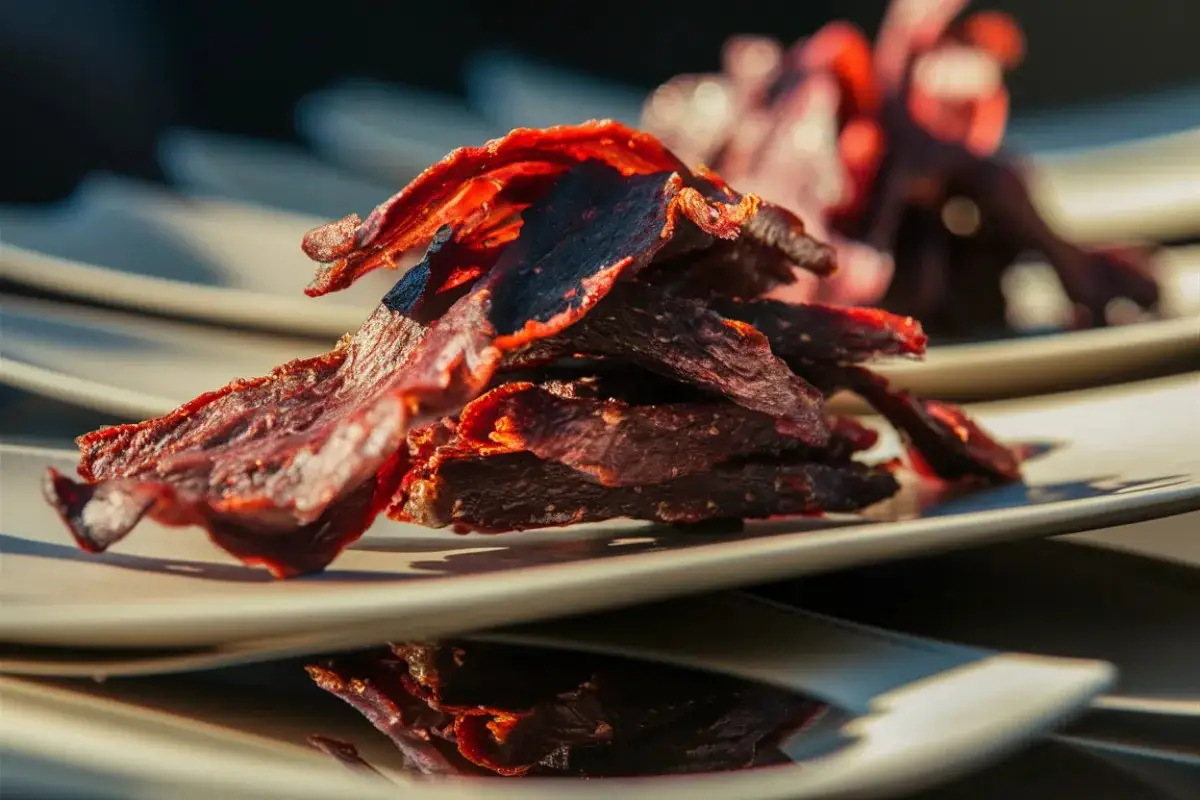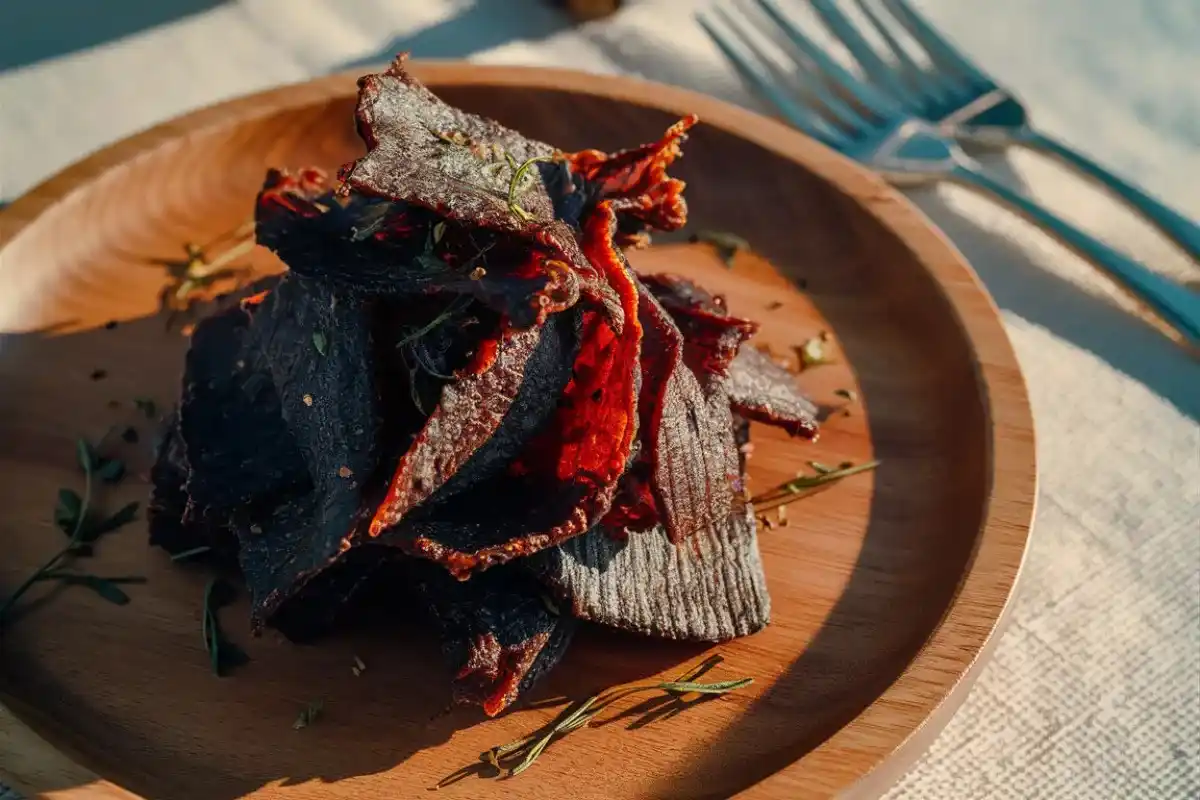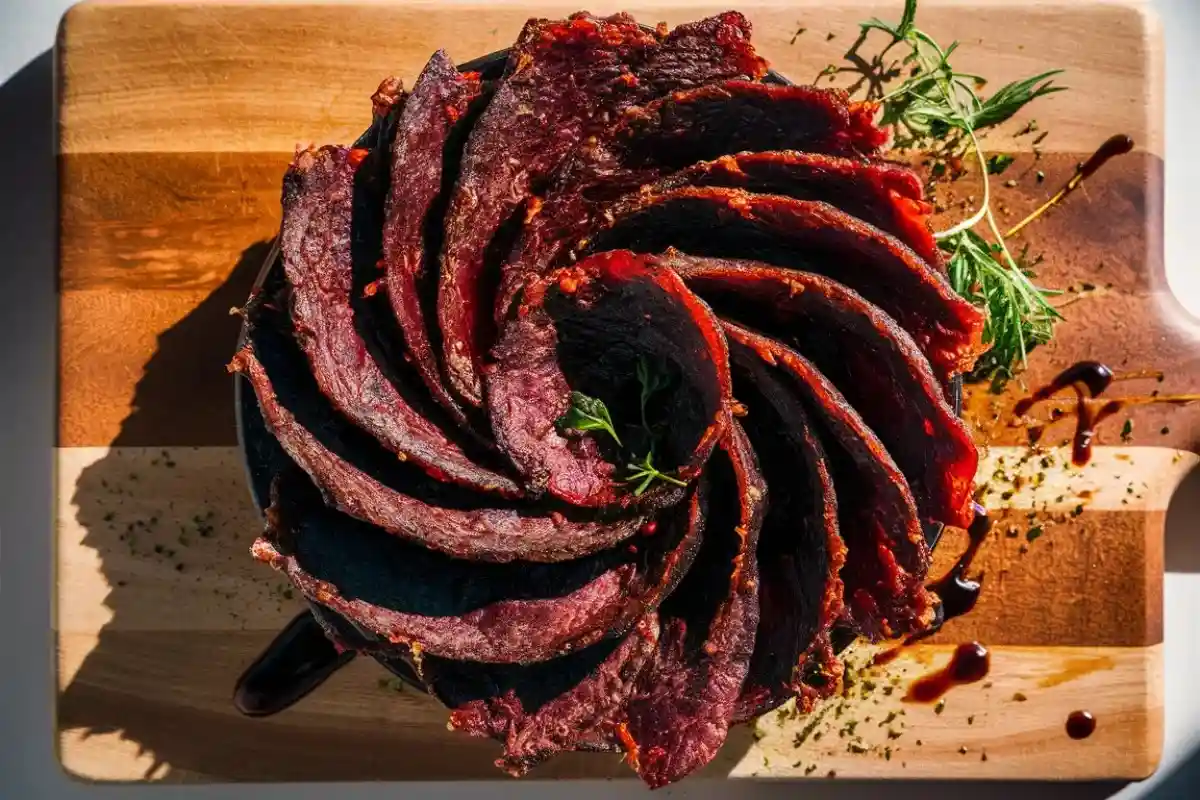People worldwide love beef jerky for its rich flavor, high protein content, and long shelf life. However, a common question that arises is: Is beef jerky just dehydrated meat? While the jerky-making process relies heavily on dehydration, people use more methods than simply drying meat. This article delves into what makes beef jerky unique, explores the detailed steps of its preparation, and compares it to other forms of dried meat.
What is Beef Jerky and Is It Just Dehydrated Meat?
People know beef jerky for its distinct flavor and chewy texture as a type of preserved meat. Originating from ancient methods of meat preservation, people historically used jerky as a reliable food source during long journeys, wars, and for survival. The process of making jerky involves marinating slices of lean meat in a blend of spices and sauces before drying them at low temperatures, transforming the meat into a durable and flavorful snack.
Jerky is not limited to beef alone; variations include turkey, chicken, and even exotic meats like venison and elk. However, beef remains the most popular choice due to its rich taste and satisfying texture. The combination of spices, marinades, and drying techniques is what elevates beef jerky beyond the realm of ordinary dehydrated meat.
The Historical Roots of Beef Jerky

The concept of preserving meat by drying can be traced back thousands of years. Early civilizations, including Native Americans and ancient Egyptians, practiced meat drying to ensure food availability during scarce times. Native American tribes, for instance, were known for making “pemmican,” a type of jerky mixed with fat and berries, which provided a highly nutritious and long-lasting food source.
Jerky was also a staple for early explorers, sailors, and pioneers who needed sustenance that could endure long travels without refrigeration. The process of making jerky has evolved significantly over time, with modern methods incorporating various seasonings and technological advancements such as dehydrators and smokers.
The Process of Making Beef Jerky: More Than Just Dehydrating Meat
The making of beef jerky is a meticulous process that involves several key steps. Each stage contributes to the jerky’s unique characteristics, differentiating it from plain dehydrated meat. Here’s a detailed breakdown of the jerky-making process:
- Selection of Meat
- The first step is selecting the right cut of meat. Lean cuts such as eye of round, top round, sirloin tip, and flank steak are preferred because they contain less fat, which can spoil over time. The goal is to use lean meat to ensure a longer shelf life and maintain a consistent texture.
- Trimming and Slicing
- The meat is carefully trimmed of any visible fat and then sliced into thin strips. Slicing against the grain produces a tender jerky, while slicing with the grain results in a chewier texture. The thickness of the slices affects drying time and the final texture of the jerky.
- Marination
- Marinating is one of the most crucial steps that sets jerky apart from plain dehydrated meat. The meat strips are soaked in a flavorful marinade that typically includes soy sauce, Worcestershire sauce, garlic, onion powder, brown sugar, and other spices. This step infuses the meat with a complex flavor profile and helps in tenderizing it.
- Dehydration
- After marinating, people place the meat in a dehydrator, oven, or smoker. Dry the meat at a low temperature, typically between 130°F and 160°F, to ensure that it dries evenly without cooking. Dehydration removes moisture, which is essential for preserving the meat and preventing bacterial growth.
- Seasoning and Finishing
- After drying, some jerky makers add an extra layer of seasoning to enhance the flavor. This step can include additional spices, pepper, or a light dusting of smoked paprika. The jerky is then allowed to cool and is stored in airtight containers to maintain freshness.
How Dehydration Works in Jerky Making and Why It’s More Than Just Drying Meat
Dehydration is the cornerstone of jerky-making, but it’s more complex than merely removing water. This process preserves the meat by:
- Removing Moisture: Water is the primary medium for bacterial growth. By removing moisture, dehydration makes the meat inhospitable to bacteria and mold, extending its shelf life significantly.
- Concentrating Flavors: Dehydration intensifies the natural flavors of the meat. As people remove water, the taste of the spices, marinades, and the meat itself becomes more pronounced, offering a rich and concentrated flavor experience.
- Texture Development: Dehydration affects the texture, creating a chewy consistency that characterizes jerky. Proper dehydration ensures that the meat is neither too tough nor too soft, striking a balance that makes it enjoyable to eat.
Key Differences Between Beef Jerky and Simple Dehydrated Meat

The critical difference between beef jerky and plain dehydrated meat lies in the preparation and flavor profile. Here’s what makes jerky distinct:
- Flavor Infusion: People marinate jerky in a mixture of spices, herbs, and sauces, infusing it with a rich taste that plain dehydrated meat lacks.
- Texture and Mouthfeel: The combination of marination and dehydration creates a chewy yet tender texture, making jerky more enjoyable than simple dried meat.
- Preservation: The spices and salts used in the marinade not only add flavor but also act as preservatives, enhancing the jerky’s shelf life beyond that of plain dried meat.
Variations of Beef Jerky: Beyond Basic Dehydrated Meat
Beef jerky doesn’t stick to one flavor or style; people make it in various forms, each offering a unique taste experience. Here are some popular variations:
- Traditional Jerky: Typically seasoned with salt, pepper, garlic, and other simple spices, traditional jerky focuses on the natural flavors of the meat.
- Teriyaki Jerky: A popular variety, people marinate teriyaki jerky with soy sauce, sugar, ginger, and garlic, which creates a sweet and savory profile.
- Spicy Jerky: For those who enjoy a kick, people often make spicy jerky with cayenne pepper, chili powder, or even hot sauce, delivering a fiery punch with every bite.
- Smoked Jerky: People prepare smoked jerky in a smoker, which gives it a distinct smoky flavor that enhances the overall taste.
- Sweet Jerky: Varieties like honey or maple-flavored jerky cater to those who prefer a touch of sweetness in their snacks.
Techniques to Make Beef Jerky at Home
Making jerky at home allows for customization and control over ingredients. Here’s an overview of different methods to make beef jerky:
- Using a Dehydrator
- A dehydrator is the most popular tool for making jerky at home. It provides consistent heat and airflow, which helps in evenly drying the meat. Most home dehydrators come with adjustable temperature settings, allowing you to fine-tune the drying process.
- Oven-Drying
- If you don’t have a dehydrator, your oven can also do the trick. Set the oven to its lowest setting (usually around 170°F), place the marinated meat strips on a wire rack, and leave the oven door slightly open to allow moisture to escape. This method is effective but may require careful monitoring to prevent over-drying.
- Smoking
- Smoking not only dries the meat but also imparts a distinct smoky flavor that many jerky enthusiasts love. Using wood chips such as hickory, apple, or mesquite adds unique flavors to the jerky, making this method particularly popular among traditionalists.
- Air Fryer Jerky
- The air fryer has gained popularity as a quick method to make jerky. While not as traditional, the air fryer can replicate the drying effect by circulating hot air around the meat. It’s a convenient option for small batches.
Exploring Global Variations: Is Beef Jerky Just Dehydrated Meat Everywhere?

Although people most commonly choose beef, they can make jerky from various meats, each offering a distinct flavor and texture:
- Turkey Jerky: Leaner than beef, turkey jerky is a healthier alternative with a lighter flavor. It’s ideal for those looking to cut back on red meat without sacrificing taste.
- Chicken Jerky: Similar to turkey, chicken jerky is light, low in fat, and easy to make at home. It absorbs marinades well, offering a blank canvas for various flavor profiles.
- Venison Jerky: For those who hunt or enjoy game meat, venison jerky provides a rich, earthy flavor. Its lean nature makes it perfect for jerky-making, though it can be tougher than beef.
- Fish Jerky: A less common but interesting variation, fish jerky (often made from salmon) provides a high-protein, omega-rich snack that’s both unique and nutritious.
- Vegan Jerky: Made from ingredients like mushrooms, soy, or jackfruit, vegan jerky mimics the texture of traditional jerky while offering a plant-based alternative.
The Influence of Global Flavors on Beef Jerky
Beef jerky is not just an American snack; it has global variations that reflect different culinary traditions:
- Biltong (South Africa): Like jerky, people make biltong with a vinegar-based marinade and often season it with coriander and other spices, giving it a distinct taste and a slightly thicker cut.
- Charqui (South America): South American countries originally prepared charqui, a traditional dried meat made with llama or alpaca meat, and seasoned it with salt and sometimes chili.
- Bak Kwa (China): A sweet and savory version of jerky, bak kwa typically uses pork, which people glaze with sugar, soy sauce, and spices. It’s often enjoyed during Chinese New Year.
- Kilishi (Nigeria): A spicy, thinly sliced dried meat coated with a paste made of ground peanuts and spices, kilishi is a popular West African snack.
Storage and Shelf Life of Beef Jerky
Proper storage is essential to maintaining the quality and longevity of beef jerky. Here are some key tips for storing jerky:
- Airtight Containers: Store jerky in airtight containers or vacuum-sealed bags to keep out moisture and air, which can lead to spoilage.
- Cool, Dry Place: Keep jerky in a cool, dry place away from direct sunlight. We recommend refrigerating homemade jerky, especially if you don’t vacuum-seal it.
- Avoid Cross-Contamination: Always use clean utensils and containers when handling jerky to prevent the introduction of bacteria.
- Freezing: For long-term storage, jerky can be frozen without losing its flavor or texture. Simply thaw at room temperature before consuming.
Common Misconceptions About Beef Jerky
Beef jerky is often misunderstood, with several myths surrounding it. Here are some common misconceptions:
- Jerky is Raw: Many people mistakenly believe that jerky is raw meat. In reality, jerky is cooked during the dehydration process, where low heat effectively kills bacteria.
- All Jerky Tastes the Same: Due to the wide variety of marinades, seasonings, and preparation methods, jerky can taste drastically different depending on the recipe and meat used.
- Jerky is Expensive: While some premium brands can be pricey, making jerky at home is cost-effective and allows for complete control over ingredients.
Frequently Asked Questions
- Is beef jerky healthy?
- While beef jerky is a high-protein, low-fat snack, its high sodium content can be a drawback. Opt for low-sodium or natural varieties when possible.
- How long does beef jerky last?
- Properly stored beef jerky can last for several months. Vacuum sealing and storing in a cool, dry place extends its shelf life. For more insights, you can explore the detailed guide on how long does beef jerky last on Talia Recipes.
- Can you make beef jerky without a dehydrator?
- Yes, beef jerky can be made in an oven or smoker. Both methods can replicate the drying effect of a dehydrator.
- Is beef jerky safe for children?
- In moderation, beef jerky can be a good source of protein for children, but watch for high sodium levels and potential choking hazards.
Variations of Beef Jerky
- Different Meats: Turkey, chicken, and even vegan versions made from soy or mushrooms.
- Flavor Profiles: Spicy, teriyaki, smoked, sweet, and many more.
Conclusion
Beef jerky is far more than just dehydrated meat; it is a complex, flavorful snack that blends tradition, technique, and innovation. From selecting the right cut of meat to experimenting with diverse marinades and drying methods, making jerky is both an art and a science. Whether you enjoy it as a quick snack or a protein-packed treat, beef jerky offers a unique culinary experience that transcends its humble origins.
If you’re eager to explore other meat preparation methods, consider diving into what to do with extra ground beef for more versatile cooking ideas. Jerky is just the beginning of what you can create with simple, accessible ingredients.

